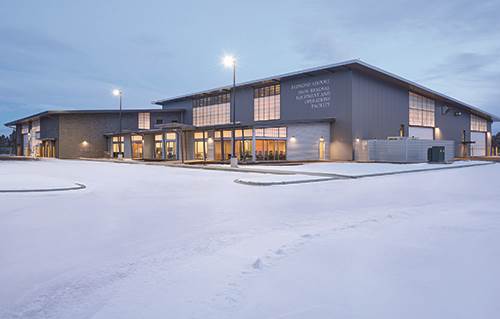The team that maintains the airfield and operates snow removal equipment at Redmond Municipal Airport (RDM) worked out of a 7,000-square-foot building with modest heavy equipment storage bays. Equipment was stored in several different places across the airfield, some outside. That led leaders at the Oregon airport to invest in a larger facility.
For the past 20 years, the team that maintains the airfield and operates snow removal equipment at Redmond Municipal Airport (RDM) worked out of a 7,000-square-foot building with three modest heavy equipment storage bays. Due to the facility’s small size, equipment was stored in several different places across the airfield, some outside without shelter. That led leaders at the central Oregon airport to invest in a much larger 45,000-square-foot facility.
 Airport Director Zachary Bass, C.M., estimates that the $14 million storage and operations building completed earlier this year makes airfield maintenance crews 30% more efficient during winter storms. “It’s the simple stuff, like not having to go outside and plug equipment in to warm it up,” Bass explains.
Airport Director Zachary Bass, C.M., estimates that the $14 million storage and operations building completed earlier this year makes airfield maintenance crews 30% more efficient during winter storms. “It’s the simple stuff, like not having to go outside and plug equipment in to warm it up,” Bass explains.
Significant increases in RDM’s passenger volume and associated additions to its fleet of snow removal equipment reinforced the ongoing need to improve storage. “We recently purchased two MB5 multitask pieces of equipment,” explains Bass. “We had nowhere to put them, so it coincided with building this new building and getting the equipment we needed to make sure that we are staying on top of inclement weather.”
|
Project: Snow Removal Equipment Operations Facility Location: Redmond (OR) Municipal Airport Size: 45,000 sq. ft. Approx. Cost: $14 million Funding: About $6.5 million in FAA primary entitlement grants; $200,000 from Critical Oregon Airport Relief Grant Program; roughly $7 million of city bonds Planning/Design: 2018 Construction: Dec. 2019-Dec. 2020 Occupied: Jan. 2021 Engineer of Record: Morrison-Maierle Inc. Architectural Design: BBT Architects Construction: Kirby Nagelhout Construction Co. Features: 2 large bridge cranes to lift heavy bags of deicer; conference room for airport & public use Snow Removal Fleet & Supplies: 2 MB5 Multitask Vehicles; MB3 broom; Tyler deice trailer with Ford 12 yard; 3 Oshkosh vehicles with various broom, blower & plow attachments; Cat loader with box blade; Root plow for Cat Loader; Case loader with box blade; Snow Dozer blower; 2 graders; Schulte blower with Ferguson tractor; 6 E-36 bulk tanks; 18 NAAC Super Sacks; replacement broom segments |
Pre-pandemic, RDM logged almost 100,000 operations per year and served about 1 million commercial customers annually. “Over the last five years, we have seen about 100% growth in passengers to push us into the small-hub category right before COVID hit,” Bass reports. “This May, we were actually 104% above our 2018 numbers.”
The city-owned airport is also home to an active flight school. At any given time, 125 to 150 students come to RDM and fly continuously for about 18 months.
Planning & Construction
“With the tremendous growth of the area, we’ve got more flights than ever. And the snow removal equipment building was already too small,” comments RDM Airport Engineer Fred LeLacheur, P.E. “We just needed to grow; so that’s what we did. This project was scheduled several years ago, and we finally went through the design.”
The new building consolidates snow removal equipment from three different storage buildings and hangars as well as outdoor locations into one indoor facility with 30,000 square feet for storage alone.
The project began with a site selection study in 2018. Engineer of record Morrison-Maierle Inc. initially considered expanding RDM’s existing snow removal equipment building near the terminal, but ultimately chose to construct a new facility on the northeast side of the airfield. “The existing site ended up being constrained on too many sides,” explains Cory Kesler, P.E., a senior airport engineer with Morrison-Maierle. “There were a lot of limiting factors [such as constraints from a nearby taxiway and the line of sight from the air traffic control tower] that affected how far we could expand or how high we could go on the existing site.”
The new location, previously used for construction staging, presented fewer constraints and provided easy airfield access for snow removal crews. Site prep included demolishing a few small buildings, which required asbestos inspection and mitigation. Crews also relocated overhead utilities and a water main. “It was a pretty clean site, so we were pretty lucky as far as that goes,” Kesler remarks.
After choosing the construction site, airport staff and the design team toured equipment facilities at three Montana airports with similar characteristics. “We asked them what they liked, what they didn’t like, and tried to incorporate those comments into this facility,” says Kesler.
Personnel from BBT Architects, the local design partner, found it helpful to see what other airports had built and ask questions about lessons learned. “I was impressed with the collaboration between airports and their willingness to be fully open and transparent,” notes Nathanael Werner, NCARB, project architect at BBT.
As planning began, the architectural firm facilitated a series of discussions to determine the airport’s goals and visions for its new building. “Design is an adventure,” Werner remarks, “and I think of design meetings as milestone moments that define the adventure.”
Five main themes emerged from the meetings:
- circulation and safety
- visibility and transparency
- natural light
- clarity and organization
- snow event meetings and collaboration
Architects distilled the list into design principles and were inspired by the image of a lantern. Werner explains that overall, the design represents the important role RDM’s snow removal and airfield maintenance team serves—keeping the airfield functional in a variety of weather conditions. Translucent windows throughout the facility, even in the storage bays, convey the lantern imagery. “At night, when the lights are on, you kind of get this glow,” Werner notes.

Construction began in December 2019 and continued through the end of 2020. A series of gates and fencing that surrounded the project site eliminated the need for Kirby Nagelhout Construction Company and its subcontractors to secure security credentials.
New Building, Features, Fleet
 LeLacheur describes the new snow removal equipment building as utilitarian, but open and bright thanks to ample natural light. Werner notes that natural light can help improve the cognitive ability of people working inside such buildings.
LeLacheur describes the new snow removal equipment building as utilitarian, but open and bright thanks to ample natural light. Werner notes that natural light can help improve the cognitive ability of people working inside such buildings.
The project team worked with Energy Trust of Oregon to maximize the efficiency of building systems and leverage associated financial incentives for components such as LED lighting and occupancy sensors that reduce energy consumption for lighting.
Beyond adding more storage space for equipment, the new facility includes areas that serve multiple purposes and improve work processes. For instance, the airport wanted a safe, efficient way to load solid deicing materials into trucks, and crewmembers suggested using cranes to lift the metric-ton bags. “But there wasn’t really any precedent for that,” notes Kesler.
So the design team planned for the equipment wash bay to also serve as a liquid deicer dispensing area and the storage bay to include a solid deicer loading area—complete with an overhead crane that lifts heavy sacks of NAAC® deicer from storage to dump them into spreader vehicles parked below. “We hadn’t seen that at other airports and just wanted to make sure everything we did was as efficient and as multifunctional as we could,” Kesler says.
Installing the two large 5-ton bridge cranes inside the building proved to be challenging work for construction crews.
On the environmental front, drainage from both deicer loading positions runs through an oil/water separator before getting discharged to the sanitary sewer. In a similar vein, the equipment fueling area is a concrete pad that is hydraulically isolated from the rest of the stormwater collection area. Runoff from this area is routed to a stormwater manhole with an oil/water stop valve. “That’s the initial stopgap we have for leaks,” Kesler explains. “Then, that stormwater is also routed to an oil/water separator with coalescing media to get any stray minor hydrocarbons that might make it through before it’s discharged to an infiltration basin.”
 The insulated metal wall panel system in the storage bay is made of thick, robust materials to minimize denting or warping over time. “It’s a white, clean surface,” adds Werner. “So with the natural light that we bring into that building, it makes the whole space look really clean and highlights the equipment.”
The insulated metal wall panel system in the storage bay is made of thick, robust materials to minimize denting or warping over time. “It’s a white, clean surface,” adds Werner. “So with the natural light that we bring into that building, it makes the whole space look really clean and highlights the equipment.”
Prior to building the new facility, RDM had to send equipment off site for major repairs and maintenance. “In the past, we’ve taken all of our equipment a couple miles away on public streets to get worked on,” Bass says. “Now, we have all the capabilities to do it ourselves.”
The building also allows for future growth. “We intend to expand staff as the airport continues to grow,” says LeLacheur.
As for the fleet, RDM has been replacing vehicles and pieces of equipment over the last four to five years. With additional storage space in the new building, the airport recently purchased two MB5 multi-function vehicles from M-B Companies. Each unit features a heavy-duty, front-mounted plow and a mid-mounted broom equipped with forced air blowers between the axles. “One of our employees can drive down the runway and do all three of those jobs simultaneously with that one piece of equipment,” LeLacheur remarks.
The airport also recently bought an MB3 sweeper and is planning to replace a large dump truck and front loader this year as it continues to update its fleet.
Beyond much-needed space for existing and future equipment, the new facility includes a metal shop and a wood shop. A conference room that was not part of initial plans is proving useful for construction meetings and other gatherings that don’t need to occur in the main terminal. Because the design team included two series of security gates, the conference room can also be used for public meetings.
Overcoming Challenges
As with many projects in 2020, the team building RDM’s new equipment building encountered months of delays due to COVID restrictions and associated difficulties procuring materials. Kesler consequently stressed the importance of remaining nimble and adapting to new situations and conditions. “In this case, being able to continue our construction meetings virtually was helpful,” he notes.
 Kesler credits Kirby Nagelhout Construction Company for managing mask usage and social distancing at the work site.
Kesler credits Kirby Nagelhout Construction Company for managing mask usage and social distancing at the work site.
Dan Brinton, the firm’s project superintendent, notes that the RDM project was interesting because it required three different types of construction for one facility: a pre-engineered metal building, a steel-stud frame portion and a section created with concrete masonry units. That said, Brinton ranks COVID-related material delays as the project’s biggest challenge.
Lessons Learned, Opportunities Created
In addition to touring other airports, the design team spent approximately six months during the preliminary design phase gathering insight from the crews who would eventually work in the new facility. “They provided detailed input on their desired building footprint and layout to make their jobs more efficient,” LeLacheur says.

Kesler notes that storage facilities for snow removal equipment are inherently large and require appropriate budgets. “Regardless of how much space you have, you’ll find a way to use it,” he says. Like LeLacheur, he highly recommends visiting other airports. “Everyone has great ideas that they’ve incorporated that might work well for other people,” Kesler relates.
With its new facility complete, RDM is now able to lease the hangars previously used for equipment storage. In addition, facilities and maintenance teams have moved into the former snow removal equipment building. Nearby space was also freed up for a 30,000-square-foot corporate hangar project that is already nearing completion. “It’s really opened up what we can do on that side of the airport where the old snow removal operations building was,” explains Bass.
Equipment and staff moved into the new building in January 2021, at the beginning of the local snow and ice season. Between the new building’s efficiencies and a mild winter, RDM only had to close for inclement weather about three hours last winter. Typically, the airport receives seven or eight large snowstorms that can dump up to 3 feet of snow; freezing fog or freezing rain is much more common.
“They have a great operation staff out there, and they do an excellent job of maintaining the airfield,” says Kesler. “I think everybody is really proud of how it ended up, and it’s kind of a cornerstone of that side of the airport.”


 facts&figures
facts&figures

